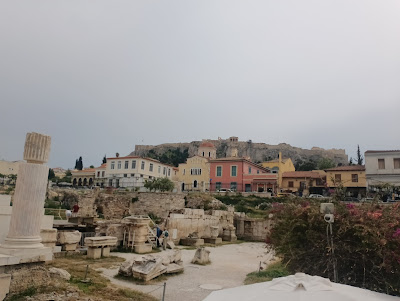Hadrian's Library
The Library of Hadrian was a large library in ancient Athens. It was named so because it was founded by the Roman emperor Hadrian. The library was also called the University of Athens.
The ancient writer Pausanias, while visiting Athens, briefly describes the Library as one of the most important buildings of Hadrian in the city:
[Hadrian constructed more buildings in Athens, like the temple of Hera and Zeus Panhellenios, the common sanctuary of all the gods (Pantheon), but of great importance is the one with the one hundred columns made of phrygian stone (the library). In the same material the stoas and the walls are made.]
Part of the library was a large inner courtyard measuring 100 × 70 meters, surrounded by an impressive peristyle. The main building of the library had two rooms, where visitors read, or attended lectures. The library hall was probably three-storeyed, but the third floor has not been preserved. The walls are thought to have been equipped with shelves with a total capacity of 18-20,000 parchments. Today the western view of the propylon with Corinthian style columns is preserved.
The archaeological site is located in Athens, in Monastiraki, north of the Acropolis. Inside its small museum is also exhibited a colossal Roman statue of Victory from the 1st century BC, which was found on the site. Right next to the library is the 18th century Tzistaraki Mosque.
Chronology
Hadrian was an ardent philhellenic and therefore frequently visited Athens during his reign from 117 to 138. The library was founded in 132. In addition to the library he also founded many other buildings, enlarged the Roman Agora and completed the Temple of Olympian Zeus.
In 267 the Library was destroyed during an attack by the Heruli. The remains were incorporated into the late Roman wall. In 412 it was renovated by the decision of the then Roman commander Erculius. With the advent of the Middle Ages, the area of the library, protected by the late Roman wall, became the heart and financial center of Medieval Athens. At the same time, a Christian church was founded in the inner courtyard, which in the 7th century was enlarged and became a royal three-aisled church.
 |
| View of Hadrian's library in 1842. |
This conversion prevented the demolition of the building. In the 11th century, the Church of Megali Panagia was built on the same foundations, which was destroyed by fire in 1884.
During the Turkish rule, Hadrian's Library was the seat of the Turkish Voivode. In 1835, Othonikos Barracks was built on the site where the Voevodaliki was housed.
On August 9, 1884, after an arson attack, the more than one hundred small shops that existed in the bazaar of the Library of Hadrian, as well as other buildings in the area, were incinerated. Megali Panagia, the oldest church in Athens, also burns. So the fact that the library area is now empty of buildings provides the right opportunity to start archaeological research in the area. Excavations at the site began in the period 1885-1886 by the Athens Archaeological Society, under the supervision of Stefanos Koumanoudis and Willelm Derpfeld. In 1950 the investigations in the area were continued by Ioannis Travlos.









Σχόλια